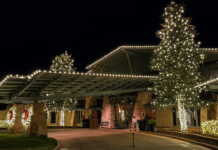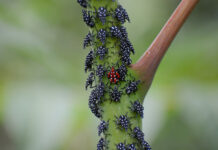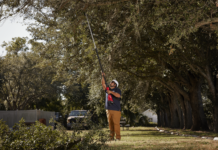
The poinsettia, a plant that represents the holiday season in the U.S., has come a long way from the days when color choices were just red or white. Last weekend, I entered the greenhouse at Colonial Nursery in Middletown, NJ, and a breathtaking sea of color greeted me. Deep burgundy, coral, neon pink, dusty rose, electric red, white, and even yellow swaths of the festive plants were on display. A closer look revealed even further divergences of traits brought about by plant breeders: frilly bracts, rounded bracts, variegated bracts, marbled bracts, upright habits, and contrasting dark leaves. It was really quite a sight!
Dan Coneeny, president of Colonial Nursery, has been a grower for over 20 years, but this was only his second year growing this variety of poinsettias. “We have found some challenges along the way for sure,” he says. “While it is not a hard crop to cultivate, you do need to pay close attention and make very timely applications of certain products to end up with the results you want. Everything from making sure that they are fertilized correctly, to keeping pests out of them, we have learned a lot along the way and are always trying to improve our next years crop.”





Enjoy these photos taken at Colonial Nursery as well as some fun facts from the University of Illinois Extension (which Turf originally ran in 2019):
- The showy colored parts of Poinsettias that people think of as the flowers, are actually colored bracts, or modified leaves.
- The bracts’ colors are created through “photoperiodism,” meaning they require darkness (12 hours at a time for at least five days in a row) to change color. Once Poinsettias finish that process, they require abundant daylight for the brightest color. (One reason why it’s hard to get them to rebloom.)
- During the 14th – 16th century, the Aztecs used Poinsettia sap to control fevers and the bracts were used to make a reddish dye. Montezuma, the last of the Aztec kings, had Poinsettias brought in by caravans.

Christmas Mouse Red 
Christmas Beauty Marble - The German botanist, Wilenow, saw the plant growing through a crack in his greenhouse. Dazzled by its color, he gave it the botanical name, Euphorbia pulcherrima meaning “very beautiful.”
- In Mexico, the Poinsettia is a perennial shrub that will grow 10 to 15 feet tall and can be found in the wild.
- In the 1820’s Joel Roberts Poinsett was the first U.S. Ambassador to Mexico. With an interest in botany, he wandered the Mexican countryside looking for new plant species. In 1828 he found a beautiful shrub with large red flowers growing next to a road. He took cuttings and brought them back to his greenhouse in South Carolina.
- William Prescott, a historian and horticulturist, was asked to give Euphorbia pulcherrima a new name as it became more popular. At that time Prescott had just published a book, Conquest of Mexico, in which he detailed Poinsett’s introduction of the plant to the U.S. Thus, Prescott named the plant the Poinsettia.
- Today the plant is known in Mexico and Guatemala as “”La Flor de la Nochebuena,” or Flower of the Holy Night, or Christmas Eve. In Chile and Peru, the Poinsettia is called the “Crown of the Andes.” In Spain the Poinsettia has a different holiday attribution and is known as “Flor de Pascua,” meaning “Easter flower.”

Autumn Leaves from a lower angle. 
Golden Glow - Though John Bartram, a Pennsylvania nurseryman, is credited as being the first person to sell Poinsettias, it was the Ecke family of California who gained the market. In the early 1900’s, the Eckes grew Poinsettias outdoors as landscape plants and cut flowers until Paul Ecke Jr. discovered a technique which caused every seedling to branch and the family industry to flourish. Then in 1991, a university graduate student published an article describing a method for causing Poinsettias to branch. With the secret out and available, competition gained ground, resulting in a decrease of Ecke’s share of the market. Today, however, the Paul Ecke Ranch in California still grows over 70% of all Poinsettias purchased in the U.S. and accounts for about 50% of Poinsettia world-wide sales. As of August 2012, the Ecke Ranch, which was family-owned and operated for nearly 100 years, announced it had been acquired by the Dutch-based Agribio Group.
- There are more than 100 varieties of Poinsettias available today. Colors include the traditional red (Prestige Red is a best seller), as well as white, pink, burgundy, marbled and speckled.
For more Poinsettia facts, growing tips, helpful links, and a list of references for the above facts, visit The Poinsettia Pages of the University of Illinois Extension here.
All Photos By Christine Menapace.


For more plant articles, see:
USDA Unveils Updated Plant Hardiness Zone Map











![[VIDEO] Dickies®: Discover Workwear That’s Anything But Uniform](https://turfmagazine.com/wp-content/uploads/2023/06/1647663814-4b1a2a7742790a9b1e97a3b963477850192e1d6a9dfba9b07214a77bae25d6e3-d-218x150.jpg)































![[VIDEO] Dickies®: Discover Workwear That’s Anything But Uniform](https://turfmagazine.com/wp-content/uploads/2023/06/1647663814-4b1a2a7742790a9b1e97a3b963477850192e1d6a9dfba9b07214a77bae25d6e3-d-324x160.jpg)